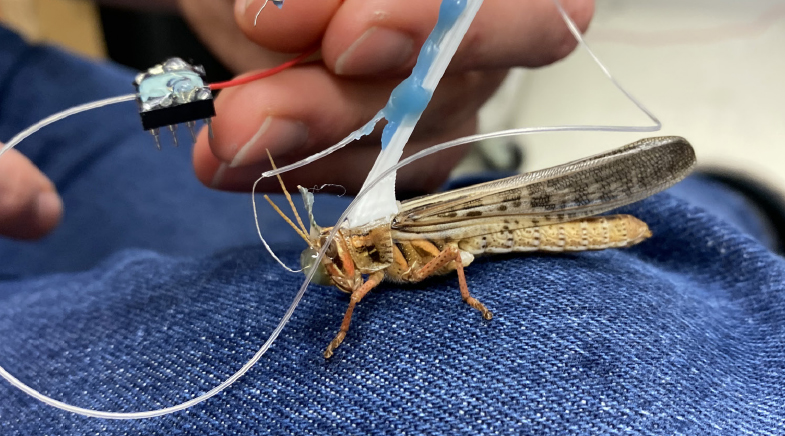Eyes wide shut
-
- from Shaastra :: vol 02 issue 04 :: Jul - Aug 2023

Advances in molecular studies and genetics are helping scientists understand the link between sleep disorders and illnesses.
His erratic sleep pattern seldom came up for discussion when the 45-year-old Chennai resident met his doctors. They knew that the senior manager was diabetic, had high blood pressure and was a smoker. But it was only after he was admitted to a city hospital following a stroke that the doctors probed further. That was when they learnt he had been facing sleep problems since his 20s. He snored heavily, and felt sleepy and tired in the daytime, which had led to problems at work and even road mishaps.
"So many doctors — including general medicine practitioners, diabetologists and cardiologists — had seen him, and he had been in emergency rooms. But nobody thought that he had sleep apnoea," says N. Ramakrishnan, Director of Nithra Sleep Clinic, in Chennai.
A study shows that people who sleep on an average less than six hours or above 10 hours a day are at a greater risk of developing diabetes.
Apnoea was one of the risk factors for the health problems the patient had been experiencing from his mid-30s. But if his sleep disorder had been dealt with when it first started troubling him, many of the complications he faced later could have been prevented, Ramakrishnan says.
Like diet and exercise, sleep is considered a pillar of health. Advances in molecular studies and genetics are now helping scientists to understand the link between sleep abnormalities and illnesses.
SLEEP-DEPRIVED BRAIN
Though many diseases are linked to disturbed sleep, the most prominent among them are neurodegenerative disorders. The relationship between neurodegenerative disorders and sleep is complex, with one feeding the other. It is difficult to understand the correlation between sleep disorders and certain neurodegenerative disorders, unless they are caused by a single faulty gene. Huntington's Disease (HD), caused by a mutation in a gene that codes for the amino acid glutamine, is one such disorder.
It is for this very reason that researchers at the Jawaharlal Nehru Centre for Advanced Scientific Research (JNCASR) in Bengaluru focused on HD while investigating the connection between sleep abnormalities and neurodegeneration. Their latest study (bit.ly/sleep-HD) demonstrated how restoring sleep and the circadian rhythm in a fruit fly model could delay the onset of HD. Apart from progressive neurodegenerative changes in the central nervous system that result in motor and intellectual disabilities, people who have HD experience common sleep problems: insomnia, difficulty in falling asleep, waking up frequently at night, and feeling excessively sleepy in the daytime.
Led by Sheeba Vasu, the JNCASR team selectively expressed an extremely virulent form of the defective HD gene in 16 neurons (out of the 100,000 neurons in the fly brain) associated with time-keeping. The researchers believe that focusing on such a narrow subset of neurons will help them understand what goes wrong inside these neurons. The onset of HD could be delayed when such circuits are identified, and their performance is improved.
Studies have shown that HD first attacks cells in selective parts of the brain. Vasu's team wanted to identify factors that could help the fly regain the brain's ability to align with its daily circadian rhythm. This, they reckoned, would address sleep fragmentation in flies.
The team then introduced an autophagy gene (autophagy is the process by which a cell breaks down and destroys old, damaged or abnormal proteins and other substances inside the gene) called Atg8a to these neurons in the fly brain, and overexpressed it so that there was an increased availability of the Atg8a protein in the neurons.
Vasu stresses that her team has been able to substantially delay the onset of the disease, despite introducing the disorder's most virulent variant in the fly. She hopes that the understanding from the study will also help in other neurodegenerative conditions. Sleep abnormalities are associated with Alzheimer's and Parkinson's, among others. They are also a major symptom in psychiatric conditions such as schizophrenia, and anxiety and addiction disorders.
For long, sleep's connection to various diseases was either assumed or based on circumstantial evidence gathered by medical practitioners. But scientists are now putting together sufficient evidence through molecular and genetic studies. "With the advancement in how we can read the brain without going in, we have certainly got a lot more information. But we still haven't got a lot more clarity," Vasu says. "But now people are appreciating how there is a connection between chronic sleep disturbances and conditions like diseases and disorders and mental health in general."
Scientists and medical practitioners are also discovering sleep's connection with heart diseases. In June 2022, the American Health Association (AHA), a body of professional medical practitioners, added sleep to a list of parameters that need to be checked for better heart health.
The AHA decision is backed by mounting evidence that good sleep is vital for healthy living. AHA revised its checklist for cardiovascular and brain health, a list that first came out in 2010. The new checklist — called Life's Essential 8 (bit.ly/heart-eight) — includes seven other health and lifestyle factors, such as nicotine exposure, physical activity, weight, blood glucose, cholesterol and blood pressure.
BLUE-LIGHT BLUES
A good night's sleep is greatly valued in the modern world of artificial lighting and smart devices that emit blue light, which is known to suppress the production of the sleep-promoting hormone, melatonin. Studies using data provided by wearables and smartwatches have shown that nearly two-thirds of people living in advanced and emerging economies are sleep-deprived. In India, the sleep-loss epidemic is further aggravated as more and more people work at night to adjust to working hours of firms operating in other time zones.
"If you ask people about non-communicable diseases, they will immediately point to obesity, diabetes, blood pressure, heart diseases and cancer. But people won't think about sleep disorders. Sleep disorders are actually the more prominent non-communicable diseases, which can lead to all of these (illnesses)," observes Ramakrishnan.

But then, there are also people who do not need more than a few hours of sleep: they are called Natural Short Sleepers. Ramakrishnan adds: "Sleep has four stages. As long as that is in the right proportion, that is good enough. It doesn't really matter whether you sleep for four hours, six hours or eight hours... If a person wakes up feeling fresh, alert and active and can carry on with routine activities, that sleep is enough for the person" (See box: 'From light to tight').
For many others, though, lack of sleep is a matter of concern. The role of poor sleep in neurological and psychiatric diseases became evident decades ago with medical observations that preceded sophisticated brain studies. "Every mental health condition will have an associated sleep and circadian dysfunction," explains Nayantara Santhi, a researcher at the Northumbria University in Newcastle upon Tyne, England. "Whether they are the cause (of an illness) or the result, we don't know yet. They can be both," she says.
Sleep's connection to disease was either assumed or based on circumstantial evidence. But scientists are now putting together sufficient evidence through detailed molecular and genetic studies.
Studies carried out on humans and animals in recent years have enabled researchers to understand the mechanisms in a sleeping brain which help manage diseases. Take the "waste clearance system" that becomes more active during deep sleep, for instance. Discovered in 2013, this glymphatic system removes metabolic wastes and misfolded proteins from the brain effectively through the cerebrospinal fluid, a colourless body fluid that circulates around tissues in the brain and spinal cord in higher-order animals. Clumps of tau and beta-amyloid proteins, implicated in Alzheimer's, are flushed out in sleep, studies show (bit.ly/Glymphatic-role).
Swami Subramaniam, an independent neuroscientist and author of the book Mastering Sleep (2019), speculates that ancient Indian practices, such as pranayama and meditation, may help improve the performance of the glymphatic system. "This is something worth studying by research institutions such as the National Institute of Mental Health and Neuro Sciences (NIMHANS) in Bengaluru," he says.

Detecting sleep disorders can also help in controlling Parkinson's. People with Parkinson's often experienced sleep disorders years before they were diagnosed with neurodegeneration. "Many patients who exhibit REM (Rapid Eye Movement) sleep behaviour disorder — in which patients are seen to become violent during REM sleep — develop Parkinson's disease ten years later," says Bindu Kutty, Professor of Neurophysiology at NIMHANS. The two diseases are seen to share degeneration in some common brain regions. Nearly 33-46% of all REM sleep behaviour disorder patients develop Parkinson's later in life.
FOR A HEALTHY HEART
At the Institute for Stem Cell Science and Regenerative Medicine (InStem), Bengaluru, Dhandapany Perundurai seeks to unravel how sleep fragmentation adversely affects heart muscle cells.
In 2009, Perundurai, then a young researcher at the Madurai Kamaraj University, was instrumental in finding out how a rogue variant of a gene, which was vital for healthy cardiac muscles, made South Asians prone to heart failure. The study showed that mutations in the myosin-binding protein C (MYBPC3) made nearly 4% of Indians prone to a disease condition called hypertrophic cardiomyopathy, which resulted in the thickening of heart muscles, made pumping of blood difficult, and eventually led to heart failures. The mutated MYBPC3 gene in South Asians exacerbates its carrier's risk of suffering a heart failure by seven times.
Detecting sleep disorders can also help in controlling Parkinson's. Many patients who exhibit REM sleep behaviour disorder develop Parkinson's years later, says Bindu Kutty (above), Professor of Neurophysiology.
Perundurai is now studying how sleep disruptions contribute to heart failure by looking into molecular mechanisms involved in the process. His team at InStem created transgenic mice models by introducing the mutated human MYBPC3 gene and subjected them to bouts of fragmented sleep over a few weeks. Their findings supported their hypothesis, and they discovered several cellular-level changes associated with sleep deprivation, which made the rodents prone to heart failure. The details of molecular changes identified in the heart muscle cells are pending publication.
Such studies are pushing scientists' understanding of the link between chronic sleep deprivation and heart failures. "To date, what is well known is that chronic sleep loss can affect coronary artery disease (CAD). But I describe CAD as something that happens outside the heart as such blocks are found in arteries that supply blood to the heart," observes Perundurai.
SLEEP AND INSULIN
Lingering sleep disturbances, often faced by people doing night shifts for long periods, are also associated with other metabolic disorders such as type 2 diabetes, obesity and hypertension. Studies have shown that sleeping just an hour or two less every day for a week can reduce the body's response to the release of insulin production, though temporarily, pushing up glucose levels in the blood, making people overeat and register higher-than-normal blood pressure values.
In June, researchers from CHA Gangnam Medical Center and CHA University's School of Medicine in Seoul, South Korea, reported something astounding. Their study, presented at the annual meeting of the Endocrine Society in Chicago, followed up over 10,000 healthy individuals over 14 years and found that people who slept on an average less than six hours or above 10 hours a day were at a greater risk of developing diabetes. About 18% of around 8,800 participants in this longitudinal study, who were examined recently, were found to have developed diabetes. The researchers observed a U-shaped relationship between sleep duration and incident diabetes — new-onset diabetes. The greatest risk was when sleep duration was greater or equal to 10 hours per day. This group also showed a decreased insulin glycogenic index, which is a marker of the insulin secretory function.
It's not just a question of sleeping hours, but of timings as well. A 2019 study, tracked over 2,000 men and women in the 45-84 age group for six years. The study (bit.ly/sleep-metabolic-disorders) found that an irregular bedtime and wake-up schedule could put a person at a higher risk of metabolic disorders. It claimed that for every hour of variability in the time of going to bed and in sleep duration, the risk of experiencing a metabolic abnormality increased by as much as 27%.
NEW TREATMENT
New studies on sleep are throwing up new ways of treatment, too. Chronomedicine is a medical domain that is exploding with the improved understanding of sleep, circadian rhythms and molecular mechanisms associated with them. It entails timing a person's medicine-taking time for best results.
"Probably the most advanced work in the field comes from cancer treatment," says Santhi. She adds that when a patient undergoes chemotherapy makes a lot of difference in the dissipation of toxicity.
With sleep becoming an important regulator of many diseases, researchers across the world are looking for biomolecules that can either act as sleep modifiers or biomarkers of potential sleep disorders, often associated with other major illnesses.
Clearly, when it comes to sleep, scientists and medical practitioners are wide awake.
FROM LIGHT TO TIGHT
The four stages of sleep.
Stage 1
Also called N1 (from Non-Rapid Eye Movement, or NREM), this is the period when a person first falls asleep. This stage normally lasts for about 1-7 minutes. In this stage, the body is not fully relaxed, though it has started to slow down, along with brain activities, with periods of brief movements. There are slight changes in brain activity associated with falling asleep in this stage.
Stage 2
During Stage 2 or N2, the body enters a more subdued state, marked by a drop in temperature, relaxed muscles, and slow breathing and heart rate. At the same time, brain waves show a new pattern and eye movement stops. Brain activity slows down.

Stage 3
The third stage or N3 is deep sleep. It is harder to wake someone up if they are in this phase. Muscle tone, pulse, and breathing rate decrease in N3 sleep as the body relaxes even further.
The brain activity during this period has a pattern of oscillations known as delta waves. That is why stage 3 is also called delta sleep or slow-wave sleep.
Stage 4
This is REM sleep, first discovered in the 1950s, when scientists studying sleeping infants noticed that there were distinct periods when their eyes moved rapidly from side to side. This stage is associated with dreaming and memory consolidation.
Have a
story idea?
Tell us.
Do you have a recent research paper or an idea for a science/technology-themed article that you'd like to tell us about?
GET IN TOUCH














